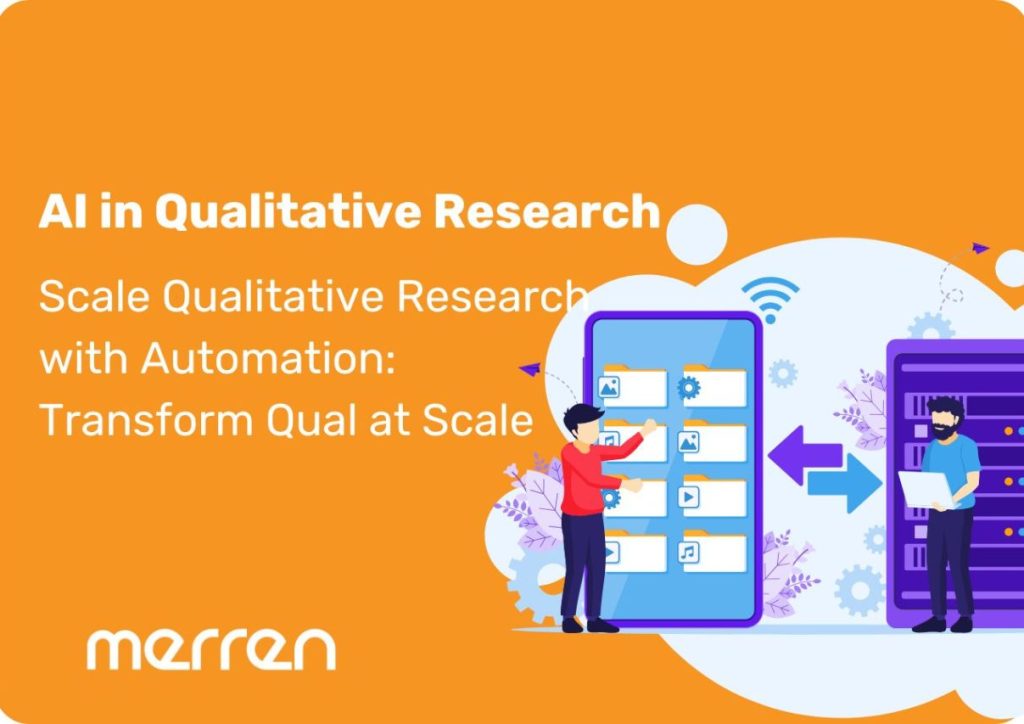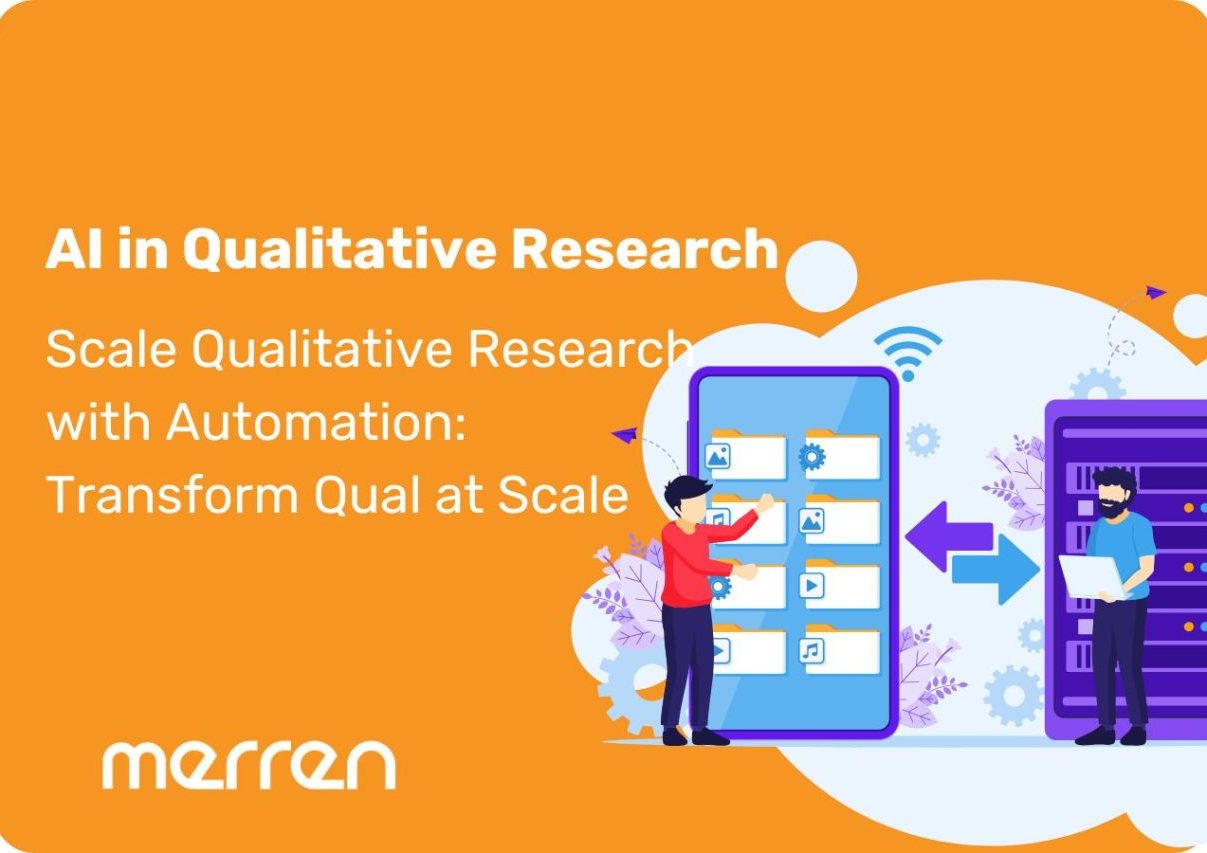Traditional qualitative research has been resource-heavy. Manual recruitment, conducting and transcribing interviews, coding responses, and synthesising findings. This restricts qualitative research to small sample sizes and niche studies. While it offers breadth, it lacks the emotional depth and nuance of human stories
Qual at scale bridges this gap. It brings together the richness of qualitative research with the reach of quantitative methods, powered by artificial intelligence (AI), automation, and human oversight. The result: authentic, large‑scale consumer insights that are both fast and actionable.
What is Qual-at-Scale?
Qualitative research at scale is the process of applying advanced AI, natural language processing (NLP), and automation to analyze large volumes of unstructured data (open‑ended survey responses, transcripts, voice notes, or discussion boards). It enables brands to:
- Capture thousands of authentic consumer voices in a fraction of the time.
- Code, categorize, and interpret open‑ended responses automatically.
- Retain the nuance and depth of human feedback while expanding reach.
Why Should Researchers Opt for Qual-at-Scale?
Manual qualitative research needs extensive resources and timelines. Automation brings speed, consistency, and reach to a process that traditionally methods cannot replicate.
Minimize traditional cost structure
Automation minimizes or replaces labor-intensive steps such as transcription, analysis, and reporting. This reduces per-project costs and allows businesses to reinvest in broader or more frequent research cycles. This gives a faster turnaround time. Automated transcription and synthesis can deliver insights within hours instead of weeks. Real-time feedback enables quicker decision-making, crucial for product development and marketing.
Reduce human-oriented bias for transparent data
Manual coding is prone to error and inconsistency. AI standardizes transcripts, sentiment analysis, and theme extraction, ensuring data quality and credibility.
Segment unstructured data minus the errors
Segmenting unstructured data can be intimidating. AI can analyze diverse inputs such as video calls, chat logs, voice notes, and open-ended surveys. AI can detect patterns and build holistic narratives from unstructured data.
Leveraging multilingual abilities in one platform
Merren can translate surveys in multiple languages. Additionally, voice surveys have the capacity to hold conversations in a multilingual framework. AI-powered translation tools enable analysis across languages for global reach.
Strategies to Implement Qual-at-Scale: From Automation to Actionable Insights
Traditional approaches demand high-touch involvement at nearly every stage: creating discussion guides, conducting interviews, transcribing conversations, analyzing open-ended responses, and compiling reports. Multiply that effort across geographies and languages, and you quickly run into diminishing ROI.
To overcome these barriers, leading teams are applying automation strategically across the qualitative workflow:
Automating discussion guides: AI-assisted drafting tools can now generate customized discussion guides based on objectives, audience segments, and prior inputs. These guides can be cross checked to maintain research intent which means teams can move faster. Learn more about creating research guides here using AI-assisted facilities.
Efficient interview execution: Chat-based interviews conducted through platforms like WhatsApp and other messaging channels humanize the experience.These asynchronous conversations can be managed by fewer moderators and even include real-time probing powered by AI.
Automated transcription and translation: Speech-to-text combined with AI translation unlocks multilingual data sets with context-based accuracy. This is critical for global qualitative research where the ability to understand context whether in Hindi, Portuguese, or Arabic matters deeply.
AI-powered thematic analysis: Natural Language Processing (NLP) can identify patterns, group sentiments, and distill unstructured input into key themes, flags, and even quotes. This lets you go beyond tagging responses manually.
Scalable reporting: Dashboards and auto-generated summaries provide instant insights without hours of slide preparation. Reports based on tag frequency, quote highlights, and sentiment trends can be delivered instantly. Researchers will be free from hours of slide-making.
The Role of AI in Digitalized Qualitative Research
AI, particularly natural language processing (NLP) and machine learning (ML), enables tasks once limited by human bandwidth to scale effectively.
- Adaptive probing: AI prompts follow-up questions in real time, mimicking live interview depth at scale.
- Multilingual NLP: AI analyzes responses in multiple languages without needing local moderators.
- Real-time text analytics: Insights emerge as responses arrive, highlighting trends and anomalies instantly.
Choose the Right Tools to Scale Qualitative Research
When selecting platforms for qualitative research automation, consider these four critical dimensions:
1. Compatibility with existing workflows
Your teams are already juggling tools across product, research, and CX. A good qualitative research solution must work seamlessly with existing systems. It could be CRM, messaging platforms like WhatsApp, or analytics dashboards. Look for solutions with open APIs or native integrations that allow easy data exchange.
2. Scale potential beyond pilot studies
A platform may work well for small sample sizes, but can it handle continuous qual research across markets? Scalability means the ability to run parallel studies, iterate instantly, and collect responses in real time, without bottlenecks. Ask about usage limits, automation capabilities, and whether the system supports adaptive methodologies like follow-up probing.
3. Multilingual capacity
To operate globally, your qual research must speak the language of your users. However, onboarding multilingual human moderators is unrealistic and costly. Choose a platform that supports multilingual surveys and automated translations across data collection, analysis and reporting. This ensures inclusivity without compromising on speed or quality.
4. Cost-effectiveness at scale
Running multiple in-depth interviews or focus groups can drain the budget fast. Automation helps reduce the per-response cost dramatically. However, affordability should not mean compromising features. Prioritize platforms that offer flexible subscription models and reduce human load through capabilities like smart guide design and AI-powered analysis.
Best Practices for Successful Qual-at-Scale
Automation can help you overcome these limitations. Here is how to implement it effectively:
Start with a pilot project
Consider selecting a single, focused research initiative before scaling full automation. Example: onboarding feedback from a specific customer segment or region. Use this as a testbed to identify what works and where there are gaps. A well-planned pilot helps fine-tune data quality and flow without overcommitting resources.
Integrate multilingual capabilities early
This is crucial if you aim to conduct research that resonates across geographies and cultures. Automation tools that support translation and adaptive probing in multiple languages allow your team to collect rich insights without hiring multiple regional moderators.
Train your team for a shift in roles
Automation can handle repetitive tasks such as transcription and coding, researchers can focus more on synthesis and storytelling. Train your team to integrate AI capabilities in their work systems. Upskilling analysts to work with real-time dashboards and AI-assisted summaries will ensure your organization remains agile and insight-driven.
Monitor performance and feedback loops
Establish clear KPIs to evaluate the effectiveness of onboarding automation. Are response times improving? Has cross-functional access to insights increased? Use feedback from both internal stakeholders and respondents to refine your approach. Regular check-ins can maintain alignment with larger CX or product goals.
How Merren Helps Brands Achieve Qual-at-Scale
Merren is an AI‑powered platform that can empower brands to collect, analyze, and act on large‑scale qualitative data without losing human depth. Merren brings AI-driven voice surveys, AI transcription, sentiment analysis, and data reporting. For brands that want to move fast without losing depth, qual-at-scale is not just an option, it’s a necessity. Merren can:
- Reduce time to insight by up to 90%.
- Cut research costs by up to 80%.
- Unlock authentic customer stories at scale.
- Blend qualitative richness with quantitative scale for actionable strategies.
Emerging trends: beyond scale
The future of qual at scale is not just bigger datasets, it’s smarter insights. Some emerging trends include:
- “Soul‑at‑Scale” Approaches: Balancing empathy with efficiency by ensuring AI preserves humanity in feedback.
- Multimodal Analysis: Combining voice, text, and video feedback for deeper emotional understanding.
- AI + HI Co‑Empowerment: Human intelligence (HI) guiding AI systems to continuously improve.
- Actionable CX Loops: Closing the loop faster by integrating findings directly into CRM, marketing, and product workflows.
Case Studies: Merren’s Qual-at-Scale in Action
1. Consumer goods brand cuts research time by 60%
A leading FMCG brand sought faster insights from rural markets across India. Previously, each qualitative study required weeks of planning and coordination, plus a full research team fluent in regional languages. By automating survey workflows and leveraging WhatsApp as a distribution channel, they ran multi-lingual surveys in parallel, with auto-translated probes and real-time dashboards.
The outcome: Over 5,000 consumer feedback in just four days with a 60% reduction in analysis time.
“Automation lets us move from reaction to anticipation. We no longer wait weeks for insights.”
2. Healthcare platform reaches remote patients
A digital health startup needed to understand patient experiences in underserved regions where in-person interviews were impractical and costly. They automated qualitative data collection through mobile-first chatbots. These chatbots supported regional dialects and layered on instant transcription and keyword tagging for faster synthesis. This gave product teams access to always-on feedback without straining the research bandwidth.
3. B2B SaaS enhances CX with in-moment feedback
A SaaS provider wanted deeper feedback from enterprise clients. They struggled with low engagement through email surveys and limited research capacity. The company switched to a real-time feedback loop using automated, language-adaptive surveys across WhatsApp and SMS. They saw a 4x increase in meaningful responses and a 35% NPS improvement within a quarter. Automation gave the customer success team time back, and the leadership team insights they couldn’t access before.
Conclusion
Traditional qualitative research is powerful but difficult to scale due to costs, manual processes, and language barriers. Automation changes this by enabling multilingual, real-time, and cost-efficient research without losing depth.
With AI-powered platforms like Merren, organizations can capture rich insights across WhatsApp, email, and chatbots in real time. Automation expands access, ensuring that every customer voice no matter the geography or language can be heard.

